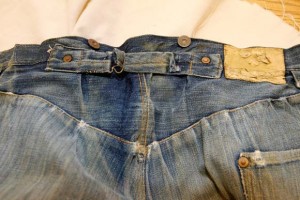“As a new article of manufacture, a pair of pantaloons having the pocket-openings secured at each edge by means of rivets, substantially in the manner described and shown, whereby the seams at the points named are prevented from ripping, as set forth.”
-U.S. Patent 139,121
You spend the night on a straw mattress in the back of Strauss’s shop. In the morning, rested, you rise early and join Strauss on the riverboat, back to the gold fields, hundreds of yards of canvas in tow.
You’re amazed at the rate of sales. Wagoneers are looking for new covers. Entrepreneurs seek canvas tenting for their new endeavors. A lone prospector dissents, yelling, “You should have brought pants! I can’t wear a pair for more than a week without tearing them.”
You and Strauss glance at each other, and an idea is born.
For the next few weeks, you run the show in Coloma; Strauss works around the clock fashioning canvas pants for the miners. They’re a hit at first, but they chafe; the fabric is almost too sturdy. You’re discussing the problem with Strauss at the San Francisco storefront when Jacob Davis enters.
Davis, a Latvian immigrant, is one of your best customers; he’s been buying stacks of canvas cloth, also trying to perfect what he calls “prospector pants”.
Soon, Davis and Strauss have it figured out — twilled indigo cotton instead of canvas called serge de Nimes (later shortened to de Nimes, then denim) — with patented rivets to reinforce the pockets.
They’re a hit out at the gold fields, prospectors stripping down in front of your canvas tent to change into the life-changing workwear.
Though blue jeans wouldn’t catch on as a casual wardrobe item until the 1960s, they made Levi Strauss & Co. the first retail giant of San Francisco in the 1880s.
And one sunny afternoon in Coloma, you sold the very first pair.
Click here to play again


